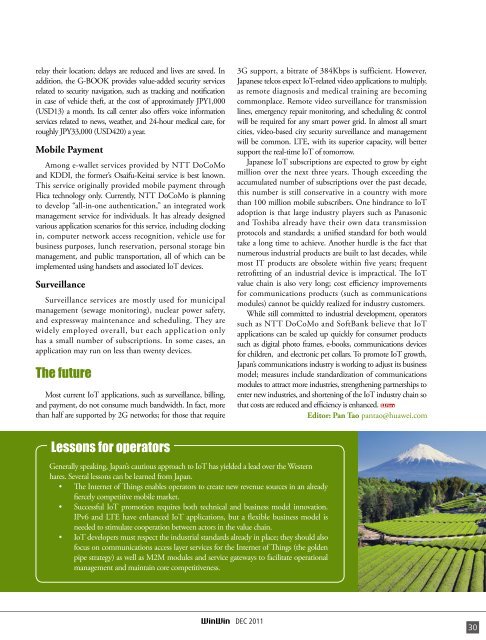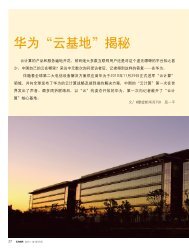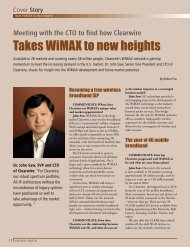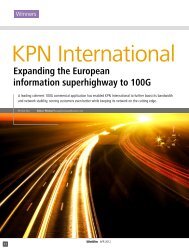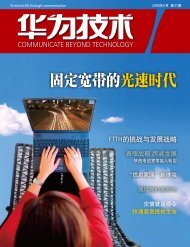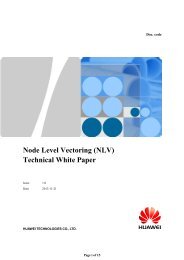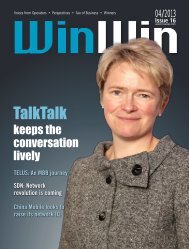Telekom Malaysia - Huawei
Telekom Malaysia - Huawei
Telekom Malaysia - Huawei
Create successful ePaper yourself
Turn your PDF publications into a flip-book with our unique Google optimized e-Paper software.
elay their location; delays are reduced and lives are saved. In<br />
addition, the G-BOOK provides value-added security services<br />
related to security navigation, such as tracking and notification<br />
in case of vehicle theft, at the cost of approximately JPY1,000<br />
(USD13) a month. Its call center also offers voice information<br />
services related to news, weather, and 24-hour medical care, for<br />
roughly JPY33,000 (USD420) a year.<br />
Mobile Payment<br />
Among e-wallet services provided by NTT DoCoMo<br />
and KDDI, the former’s Osaifu-Keitai service is best known.<br />
This service originally provided mobile payment through<br />
Flica technology only. Currently, NTT DoCoMo is planning<br />
to develop “all-in-one authentication,” an integrated work<br />
management service for individuals. It has already designed<br />
various application scenarios for this service, including clocking<br />
in, computer network access recognition, vehicle use for<br />
business purposes, lunch reservation, personal storage bin<br />
management, and public transportation, all of which can be<br />
implemented using handsets and associated IoT devices.<br />
Surveillance<br />
Surveillance services are mostly used for municipal<br />
management (sewage monitoring), nuclear power safety,<br />
and expressway maintenance and scheduling. They are<br />
widely employed overall, but each application only<br />
has a small number of subscriptions. In some cases, an<br />
application may run on less than twenty devices.<br />
The future<br />
Most current IoT applications, such as surveillance, billing,<br />
and payment, do not consume much bandwidth. In fact, more<br />
than half are supported by 2G networks; for those that require<br />
3G support, a bitrate of 384Kbps is sufficient. However,<br />
Japanese telcos expect IoT-related video applications to multiply,<br />
as remote diagnosis and medical training are becoming<br />
commonplace. Remote video surveillance for transmission<br />
lines, emergency repair monitoring, and scheduling & control<br />
will be required for any smart power grid. In almost all smart<br />
cities, video-based city security surveillance and management<br />
will be common. LTE, with its superior capacity, will better<br />
support the real-time IoT of tomorrow.<br />
Japanese IoT subscriptions are expected to grow by eight<br />
million over the next three years. Though exceeding the<br />
accumulated number of subscriptions over the past decade,<br />
this number is still conservative in a country with more<br />
than 100 million mobile subscribers. One hindrance to IoT<br />
adoption is that large industry players such as Panasonic<br />
and Toshiba already have their own data transmission<br />
protocols and standards; a unified standard for both would<br />
take a long time to achieve. Another hurdle is the fact that<br />
numerous industrial products are built to last decades, while<br />
most IT products are obsolete within five years; frequent<br />
retrofitting of an industrial device is impractical. The IoT<br />
value chain is also very long; cost efficiency improvements<br />
for communications products (such as communications<br />
modules) cannot be quickly realized for industry customers.<br />
While still committed to industrial development, operators<br />
such as NTT DoCoMo and SoftBank believe that IoT<br />
applications can be scaled up quickly for consumer products<br />
such as digital photo frames, e-books, communications devices<br />
for children, and electronic pet collars. To promote IoT growth,<br />
Japan’s communications industry is working to adjust its business<br />
model; measures include standardization of communications<br />
modules to attract more industries, strengthening partnerships to<br />
enter new industries, and shortening of the IoT industry chain so<br />
that costs are reduced and efficiency is enhanced.<br />
Editor: Pan Tao pantao@huawei.com<br />
Lessons for operators<br />
Generally speaking, Japan’s cautious approach to IoT has yielded a lead over the Western<br />
hares. Several lessons can be learned from Japan.<br />
• The Internet of Things enables operators to create new revenue sources in an already<br />
fiercely competitive mobile market.<br />
• Successful IoT promotion requires both technical and business model innovation.<br />
IPv6 and LTE have enhanced IoT applications, but a flexible business model is<br />
needed to stimulate cooperation between actors in the value chain.<br />
• IoT developers must respect the industrial standards already in place; they should also<br />
focus on communications access layer services for the Internet of Things (the golden<br />
pipe strategy) as well as M2M modules and service gateways to facilitate operational<br />
management and maintain core competitiveness.<br />
DEC 2011<br />
30


